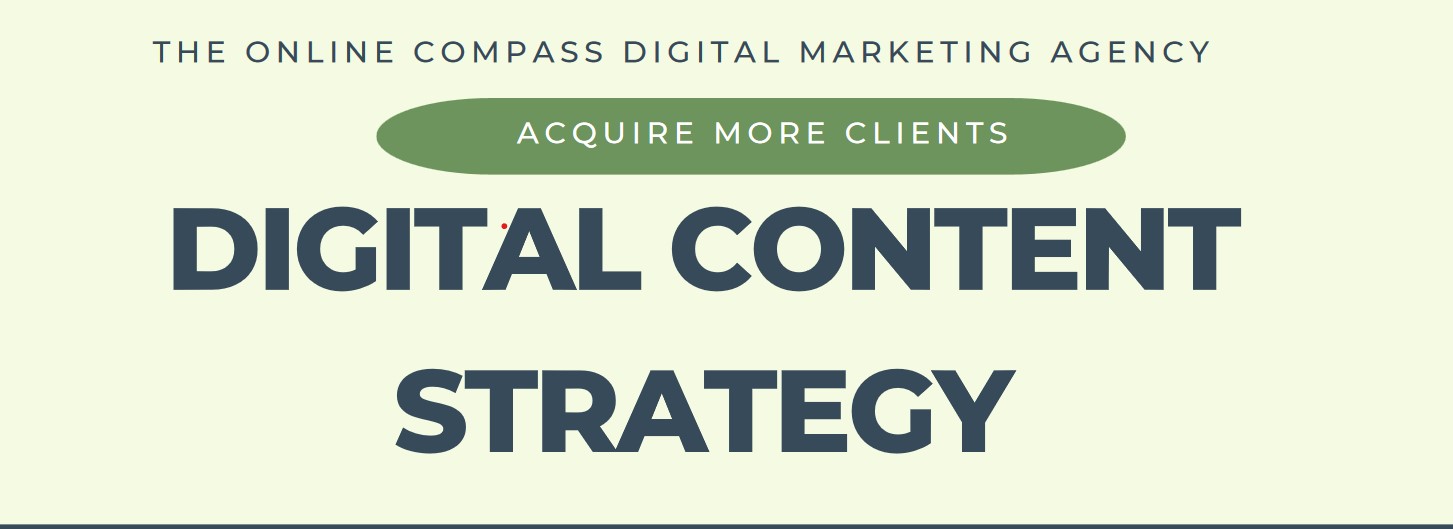Unlock the Power of Digital Content Strategy
Your Ultimate Guide to Creating Winning Marketing CampaignsAre you struggling to see results from your digital marketing efforts?
Do you feel like you’re putting in a lot of work, but not getting the engagement or conversions you need? If so, it may be time to consider the importance of a digital content strategy.
In this post, we’ll explore what a digital content strategy is, why it’s important, and how to create one that works for your business.
What is a digital content strategy?
A digital content strategy is a plan of action for creating and distributing valuable, relevant, and consistent content to attract and retain a clearly defined audience — and, ultimately, to drive profitable customer action.
Nowadays, with the ever-increasing amount of digital content available online, having a well-thought-out digital content strategy is more important than ever.
Without one, your content may get lost in the sea of information available, and your target audience may never find it.
A digital content strategy enables you to identify your audience and create content that resonates with them, making it more likely that they will engage with your brand and become loyal customers.
It also ensures that your content is aligned with your business goals and that you are maximizing the impact of your content efforts.
So, why is having a digital content strategy so important?
The short answer is that it can make or break your digital marketing efforts.
By taking the time to develop a strategy that is aligned with your business goals and that resonates with your target audience, you can create content that drives traffic, generates leads, and ultimately, increases your revenue.
In the rest of this blog post, we will be delving deeper into the key components of a digital content strategy and providing practical tips for developing your own strategy.
The short answer is that it can make or break your digital marketing efforts.
By taking the time to develop a strategy that is aligned with your business goals and that resonates with your target audience, you can create content that drives traffic, generates leads, and ultimately, increases your revenue.
In the rest of this blog post, we will be delving deeper into the key components of a digital content strategy and providing practical tips for developing your own strategy.
Understanding Your Audience: Key Component of a Digital Content Strategy
Understanding your audience is a critical component of developing an effective digital content strategy.
By defining your target audience and conducting thorough market research, you can gain a deeper understanding of their needs, preferences, and pain points. This enables you to create content that resonates with your audience and drives engagement. One effective way to understand your audience is by creating buyer personas.
Our post on target audience we’ll explore the importance of defining your target audience, conducting market research, and creating buyer personas in the context of developing a digital content strategy.
Setting Your Goals
Setting clear goals is an essential step in developing a successful digital content strategy. Your goals should be specific, measurable, attainable, relevant, and time-bound (SMART) to ensure that you have a clear direction for your content marketing efforts.
Firstly, it’s crucial to define your business goals, which are the overall objectives of your organization. These goals could include increasing revenue, improving customer retention, or expanding your market share.
Once you have defined your business goals, it’s time to define your digital marketing goals. These goals should align with your business objectives and focus on how you will use digital channels to achieve them. Examples of digital marketing goals include increasing website traffic, generating more leads, and improving conversion rates.
It’s also important to align your goals with your target audience. Your digital content strategy should be designed to meet the needs and preferences of your target audience, so it’s crucial to ensure that your goals are relevant to them.
For example, if your target audience is primarily interested in educational content, your digital marketing goals could focus on creating more informative blog posts or webinars.
By setting clear and relevant goals, you can create a roadmap for your digital content strategy that will guide your efforts and help you measure your success.
Creating your content
Creating high-quality content is at the core of any successful digital content strategy. Once you have defined your target audience and established your goals, it’s time to start creating content that will resonate with your audience and achieve your objectives.
In this section, we’ll discuss the different types of digital content, the content creation process, content distribution channels, and measuring content performance.
Types of Digital Content
Digital content can take many different forms, including blog posts, social media updates, videos, infographics, podcasts, and more. It’s important to understand which types of content will be most effective for your audience and your goals.
For example, if your target audience prefers visual content, you may want to focus on creating infographics or videos.
Similarly, if you want to increase engagement on social media, short-form content like memes or GIFs might be the way to go.
Content Creation Process
Creating high-quality content requires a structured approach that includes planning, research, writing, editing, and design.
Your content creation process should be tailored to your business and audience needs, and should be flexible enough to adapt to changing trends and priorities.
The key is to ensure that your content is consistent, relevant, and valuable to your audience.
Content Distribution Channels
Once you have created your content, it’s time to distribute it to your audience. There are many different distribution channels to consider, including social media, email marketing, search engine optimization, and more.
Again, it’s important to understand which channels will be most effective for your audience and your goals.
For example, if your target audience is active on Instagram, you may want to focus your distribution efforts on that platform.
Measuring Content Performance
Finally, it’s essential to measure the performance of your content to determine what’s working and what’s not.
This will help you refine your strategy over time and achieve better results. Some key metrics to track include pageviews, engagement rates, conversion rates, and social media shares.
By regularly analyzing your content performance data, you can identify areas for improvement and optimize your digital content strategy for succes
Again, it’s important to understand which channels will be most effective for your audience and your goals.
For example, if your target audience is active on Instagram, you may want to focus your distribution efforts on that platform.
Creating a content calendar
Creating a content calendar is a crucial step in executing a successful digital content strategy. It enables you to plan and organize your content in advance, ensuring that you are delivering consistent and relevant content to your audience.
In this section, we’ll explore the importance of creating a content calendar and how to do it effectively.
Defining your content calendar involves deciding on the frequency and timing of your content releases, as well as the types of content you will be publishing. It’s important to take into consideration your target audience and their preferences when determining the frequency and timing of your content releases. For instance, if your target audience is mainly professionals, you may want to release content during their commuting hours or lunch breaks.
Once you’ve defined your content calendar, you can begin the content creation process. This involves brainstorming ideas, researching, writing, editing, and designing your content.
You should also consider which content distribution channels you will be using to reach your audience.
Examples of distribution channels include social media platforms, email marketing, blogs, and podcasts.
Measuring the performance of your content is an essential part of your digital content strategy. You can use various tools such as Google Analytics, social media analytics, and email marketing analytics to track your content’s performance. This helps you to identify what’s working and what’s not, and adjust your strategy accordingly.
Using your content calendar involves staying organized and consistent in your content creation and distribution. You should keep track of your content releases, deadlines, and promotions to ensure that you are delivering high-quality content to your audience on time.
Creating a content calendar is a vital step in your digital content strategy. It helps you to stay organized, plan ahead, and deliver consistent and relevant content to your audience. By defining your content calendar, creating quality content, and measuring its performance, you can achieve your digital marketing goals and drive engagement with your audience.
Creating a distribution channel
Creating a Distribution Plan
Once you’ve created your content, it’s essential to develop a distribution plan that helps you get it in front of your target audience.
This involves defining your distribution channels and creating a plan for sharing your content through those channels.
Defining Your Distribution Channels
There are numerous distribution channels available for digital content, including social media platforms, email marketing, search engine optimization, paid advertising, and more.
To determine the most effective channels for your content, you need to consider your target audience’s preferences and behaviors.
For instance, if your target audience is active on social media platforms like Facebook and Instagram, then social media marketing may be a suitable distribution channel for your content.
Creating a Distribution Plan
Once you’ve identified the most effective distribution channels for your content, it’s time to create a plan for sharing your content through those channels.
This involves developing a content calendar that outlines the specific pieces of content you’ll share through each channel and the dates on which you’ll share them.
You should also consider the frequency and timing of your content distribution to ensure that your content reaches your audience when they’re most likely to engage with it.
How to Measure Distribution Performance
To determine the effectiveness of your content distribution plan, you need to measure its performance regularly.
This involves tracking key metrics like website traffic, social media engagement, email open rates, and click-through rates.
By analyzing these metrics, you can identify which distribution channels are driving the most traffic and engagement and adjust your distribution plan accordingly.
creating a distribution plan is an essential component of a successful digital content strategy.
By defining your distribution channels, developing a distribution plan, and measuring your distribution performance, you can effectively distribute your content and reach your target audience.
Measuring success
Measuring the success of your digital content strategy is crucial to ensuring that it is effective and achieving your desired results. Key performance indicators (KPIs) are metrics that you can use to track the performance of your digital content strategy. By measuring your content and distribution performance against your KPIs, you can gain insights into what’s working and what’s not, and adjust your strategy accordingly.
Some common KPIs for digital content strategy include website traffic, click-through rates, conversion rates, engagement rates, and social media metrics such as likes, shares, and comments. It’s important to identify the KPIs that are most relevant to your business and align with your goals.
Measuring content and distribution performance requires the use of analytics tools such as Google Analytics, which can help you track website traffic and behavior, and social media analytics tools that provide insights into engagement and audience demographics. By analyzing this data, you can gain insights into what types of content are resonating with your audience and which distribution channels are most effective.
Once you have analyzed your data, you can adjust your digital content strategy accordingly.
This may involve creating more of the content that is performing well, adjusting your distribution channels, or experimenting with new types of content. It’s important to continuously analyze and adjust your strategy to ensure that it is meeting your business goals and resonating with your target audience.
Measuring the success of your digital content strategy through the use of KPIs and analytics tools is crucial to achieving your business goals.
By continuously analyzing and adjusting your strategy, you can ensure that your content is resonating with your target audience and driving engagement.
Conclusion
In conclusion, a successful digital content strategy involves understanding your audience, setting clear goals, creating and distributing valuable content, and regularly measuring performance to make adjustments as needed.
Defining your target audience and creating buyer personas can help you create content that resonates with your audience, while setting business and digital marketing goals can help align your content with your overall objectives. It’s important to have a well-defined content calendar and distribution plan, as well as to regularly measure and analyze your content and distribution performance using key performance indicators (KPIs).
By continuously evaluating and adjusting your digital content strategy, you can ensure that your content stays relevant, engaging, and effective in achieving your business goals. Remember, the digital landscape is constantly evolving, so it’s essential to stay up-to-date and adapt your strategy accordingly.










